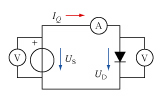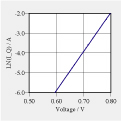If electric charge is to flow through conductive (or resistive) meaterials, a voltage has to be set up across the element. There is a characteristic relation between the voltage and the electric current for the particular element. This is true for simple ohmic materials, and for non-ohmic ones such as the semi-conductors found in diodes. Using the circuit depicted above, we can take I_Q – U_D data to draw the diode characteristic shown in the diagram on the left. A part of the data has been represented in a logarithmic graph on the right. Not shown here is data for negative values of the voltage U_D: The current remains close to zero.
a. Describe the characteristic of the diode. Use this to understand the function of a diode in a circuit. b. It is said that a diode functions analogously to a valve in hydraulics. What would be the characteristic of an ideal valve? How does the diode characterisitc differ from this? c. How could the characteristic of an ideal valve be changed to roughly resemble that of a diode? d. If the (natural) logarithm of the current I_D is taken (Graph), a straight line results from the data. Use this to show that I_D(U_D) = Io·exp(a·U_D) is a good correlation for the data. Use the graph to determine a and Io. | | e. For physical reasons, the relation found in d cannot be correct. A better correlation is I_D(U_D) = Io·[exp(a·U_D) – 1] Why does this make sense on physical grounds? f. Taking the correlation in e, why does a determination of the parameters a and Io yield pretty much the same values as those found in d? g. Assume that the ammeter used in the experiment has an internal resistance of 1.25 Ohm. When U_D = 0.75 V, what is U_S? |


